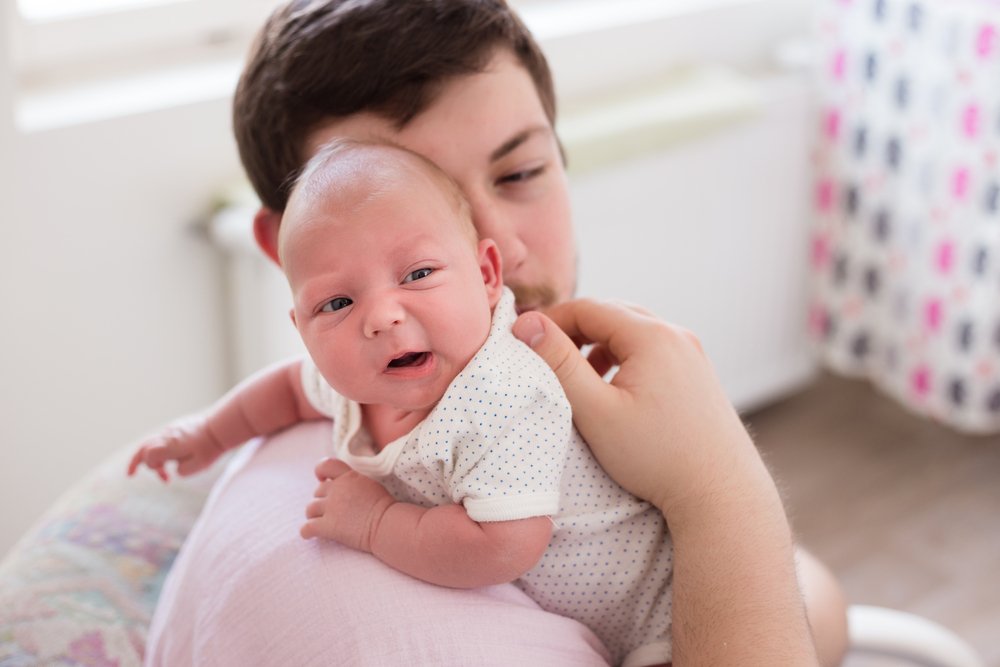Key points:
- Burping is important for babies as it helps them get rid of excess gas and settle their stomach.
- There are different effective burping positions, including over your shoulder, across your lap, and sitting on your lap.
- Spitting up is normal for babies, but vomiting is different and might require consulting a doctor.
- There are tips to reduce spit-up and make babies more comfortable, such as feeding them before they’re too hungry and positioning the bottle correctly. It’s also important for new parents to relax and find what works best for them.
When caring for a newborn, one of the first new parent skills you’ll learn is how to burp a baby. Every burp your baby makes serves a purpose. Why do babies burp? Is burping my baby after meals important? Getting your degree on this new skill will take you on a journey filled with joys, dribble, and, of course, extra loads of laundry.
The art of burping
Burping is caused by air swallowing; a burp is the release of the gas up the esophagus and out of the mouth. Burping your baby is a way you can help them get rid of gas and settle their stomach.
Fussiness and gas often go hand-in-hand in babies. When your baby is born, their tummy is the size of a marble. It will grow to be the size of an egg around day 10 and eventually will grow to be the size of a softball. Since your little one’s digestive system is developing, they might experience some discomfort associated with gas and might need your help with that.
How to burp a baby
When bottle-feeding, give your baby a chance to burp midway through and at the end of the feeding. Keep the nipple full of formula throughout the feeding, this will reduce the air ingestion. When breastfeeding, give them a chance to burp when you switch breasts, and after the feeding.
These are some effective burping positions:
- Over your shoulder: Hold your baby against your chest with their head supported on your shoulder. Gently pat their back with your hand.
- Across your lap: Gently lay your baby face down across your legs, making sure that their head is supported. Softly rub their back.
- Sitting on your lap: Sit your baby on your lap, supporting their chin with one hand. Lean your baby forward and gently pat their back.
Spitting up and vomiting
Most babies spit up after eating, especially at first. When your baby’s stomach is full or their position is changed suddenly after a feeding, the milk inside their stomach can flood back up the esophagus.
There’s a difference between spitting up and vomiting. The American Academy of Pediatrics (AAP) defines vomiting as “forceful throwing up of stomach contents through the mouth”. Some babies vomit occasionally, if the vomiting is recurrent and continues is best to consult your baby’s doctor. A spit-up is defined as “easy flow of stomach contents out of the mouth, frequently with a burp or wet burps”. Spitting up 1 or 2 mouthfuls of milk at a time with no effort or crying is a normal symptom in young babies. This is when burping cloths come in handy. Some babies spit more than others, a few ‘heavy spitters’ will continue to do so until they start to walk.
Every baby is different, and it’s okay not to get a burp with every burping attempt. In general, breastfed babies tend to burp less than bottle-fed babies. This is because they tend to swallow less air when feeding. The same happens to babies that like being fed in a more upright position; naturally, they’ll have less trapped air than those who eat in a more horizontal position.
Some tips to reduce the spit-up and making your baby more comfortable
- Respect your baby’s time for meals. Feeding them before they’re too hungry will reduce the chance of them eating too much, too quickly, or swallowing more air in the attempt to eat.
- Hold your baby in an upright position, maintaining their head above their abdomen.
- Position the bottle correctly, tilting it a little so there are no airways. If your baby is breastfed, make sure they are properly latching on to the nipple. This will reduce the chance of your baby swallowing too much air, causing indigestion.
- Changing your baby’s position can help move those gas bubbles that need to be released.
- Give your baby a nice calm environment when feeding, this will make them feel more comfortable and not rushed.
Something to keep in mind
Relax and enjoy your baby. There’s no definitive age to stop burping your baby, but as your little one gets older their digestive system will become stronger, making burping them less necessary. Also, when you learn how to burp a baby, remember there is also no “right way” to go about burping your baby. As a new parent, feel the liberty to try multiple combinations of feeding and burping positions and find out what works best for you when taking care of your little one.








